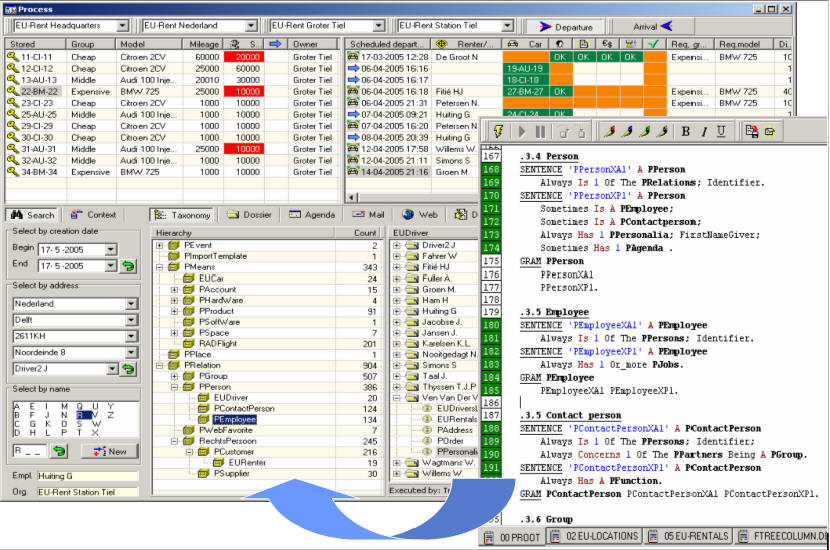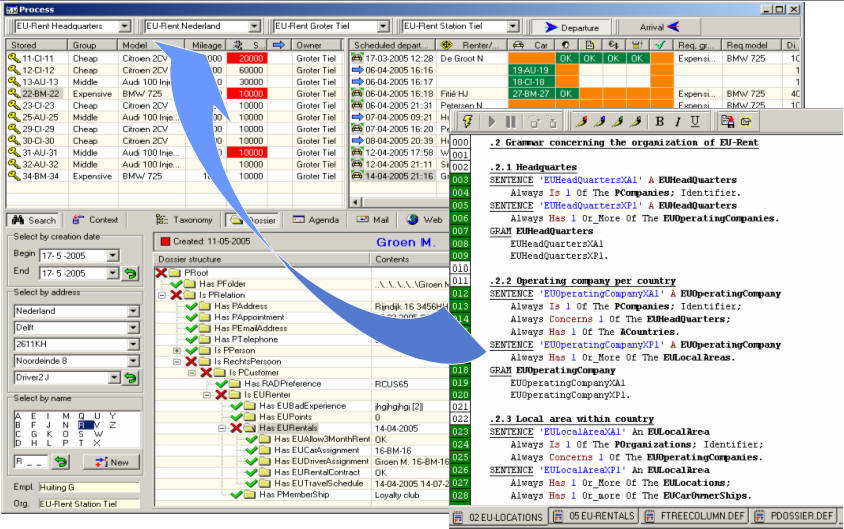| 1 Communication | 2 Elements | 3 Engine | 4 Small application | 5 Heavy application | 6 Download | 7 Notes |
![]() 5
Building a heavy business rules
application
5
Building a heavy business rules
application
5.1 Introduction
EU-Rent is a case study developed by the Business Rules Team. It was designed with the purpose of bringing together all kinds of business rules (BR) in a comprehensive example. For more details on EU-Rent see www.eurobizrules.org/eurentcs/eurentoview.htm [Broken Link]. The case study offered a good opportunity to verify whether CommunSENS could deal with such a complicated process.
Overview of EU-Rent
EU-Rent is a (fictitious) car rental company with branches in several countries.
It provides typical car rental services:
This case study deals with only a part of EU-Rent’s behaviour, triggered by the following kinds of event:
To get EU-Rent running (version 5, 10/11/2004) we used:
The purpose of this section is to show how such an application can be embedded in the knowledge engine.
5.2 Taxonomy
Most application that focus on commercial activities deal
with people, organizations, means, etc. In order to avoid defining such entities
over and over again, a taxonomy has been developed. The idea is that once you
have a suitable taxonomy it should be easy to add new specializations to it. In
the lower part, figure 5.1 gives an example for the subject Person. The first
sentence (PPersonXA1) says that a person is a specialization of a relation. The
second sentence says that such a person can become an employee or a contact
person (of an organization). Moreover, any person must have personalia (first
name, family name, gender, etc.).
To add the relevant entities of the EU-Rent case to the taxonomy additional
sentences can be added like
Utterance 1: A Driver Always Is 1 Of
The Persons.
Utterance 2: A Car Always is A Means.
| Figure 5.1: Taxonomy |
 |
The taxonomy is embedded in a form called PProcess. This form contains general functionality like an agenda, mail boxes, internet etc. This functionality is positioned at the lower side of the form.
5.3 Specific functionality
At the top side of the form there is room for specific functionality. In this case the structure of the EU-Rent organization is given together with a part of the rental process. As can be seen in figure 5.2, this organizational structure is also hooked to the taxonomy.
| Figure 5.2: Organixation of EU-Rent |
 |
5.4 Defining the process
The next step is defining the rental process by formulating relevant ex post sentences. Figure 5.3 shows some sentences that must be true for rentals. The first sentence prescribes that for every rental that is not ended there should be a travel schedule. The second sentence dictates that for every rental with a travel schedule there must be an assignment of a car and driver(s). The third sentence says that after these assignments are made, there must be a rental contract and a provisional charge on the credit card. Moreover, it should be checked that the car is fully fuelled. When all this is done the car can leave.
| Figure 5.3: Rent process |
 |
The state of the rental process is mirrored in the dossier by adding a node to the tree. If the node has a red cross associated with it then there is at least one sentence that is not true for that node (or for any of its children). Basically, for any process, the user must follow the crosses and perform appropriate actions to make the sentences true. Consequently, if all nodes have a green check mark the dossier is ready.
Sometimes it is useful to present a process as a list of consecutive actions. In this example such a view is presented at the top right part of the illustration. By clicking a cell the necessary action will be executed.
5.5 Towards solid ontology's
In the form PProcess a first attempt has been made to incorporate several kinds of knowledge. As mentioned before the form is equipped with some general knowledge of the world (taxonomy, agenda, mail, etc.) Besides these aspects, the basic principles of bookkeeping, ordering, delivering, etc. have been formulated. The main goal of the future development will be to verify, validate and extend this general knowledge. If it is possible to create solid ontology's, developing new applications can really become modulair.
| 1 Communication | 2 Elements | 3 Engine | 4 Small application | 5 Heavy application | 6 Download | 7 Notes |
Copyright © 2005 by AB Ontwikkeling BV
All Rights Reserved. Any reproduction or reuse of these pages or
their contents requires the advance permission of AB Ontwikkeling BV.